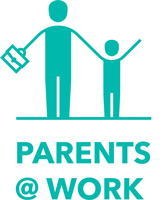Checklists
The checklists below show what you are legally obliged to do, as well as what else you can do (see ‘tips’) to make your company more family-friendly.
They are primarily aimed at companies in the private sector with at least one employee, i.e. not the self-employed. The legal rights and obligations may vary for the self-employed or staff in the public sector; these have not been included in the toolkit at present.
For some arrangements or types of leave, your employee must meet certain employment or length of service conditions. Specific information on this can be retrieved at any time on the websites to which we refer.
These checklists are not exhaustive, but they provide an initial tool for getting started. Naturally, you should always review what is necessary and possible at your company.
Checklist 1: Prior to the birth/pregnancy
How can you prepare the company for a pregnant employee? This checklist covers things you can do before you are confronted with an actual pregnancy. A well-prepared employer is worth their weight in gold.
Checklist 2: medically assisted reproduction
Undergoing treatment for medically assisted reproduction can be very stressful for an employee, as well as for her/his partner. Take a look at what you as an employer can do when there is extra pressure at home.
Checklist 3: During pregnancy
An employee has told you she is pregnant. What now? What things need to happen and what other things can you do to make it as comfortable as possible for yourself, the colleagues and the pregnant employee?
Checklist 4: Breastfeeding
Your employee is back at work and is still breastfeeding her child. There are a few legal obligations and bits of administration that you need to take account of here as an employer. There are some extra measures you can take to make things as comfortable as possible for the employee.
It is not only the pregnant employee who is entitled to leave and protections; her partner also has rights. They are undergoing a major change in their private life, which you as an employer would be well-advised to take account of.
Checklist 6: In the event of adoption or foster parenting
There are several different ways to become a parent. You can also adopt a child or become a foster parent. This is just as radical an event as a pregnancy and also has a tangible impact on one's private life. Adoptive or foster parents are equally entitled to leave and protection against dismissal.
Checklist 7: Parental leave
Unexpected events or new phases of the child's life can once again disrupt the balance between one's work and private life. Parental leave for both parents can provide an answer to this.
When children get ill or other family members need care, it is sometimes difficult to combine one's private life with work smoothly. This is why there are various forms of care leave, namely palliative leave, medical support leave and informal care leave.
Does your employee need more time to take up a caring role for family members or the children? Then time credit may be a solution. This checklist discusses the motives for which time credit can be requested, along with the periods and administrative details important for this.
Specific situations
What if specific situations occur (such as your employee expecting twins or adopting a child with a disability), or things do not go as planned (such as your employee having a miscarriage or the mother dying during childbirth)? As an employer, you need to be able to provide an answer to this too. This page offers a glimpse of these specific situations and the associated regulations.

